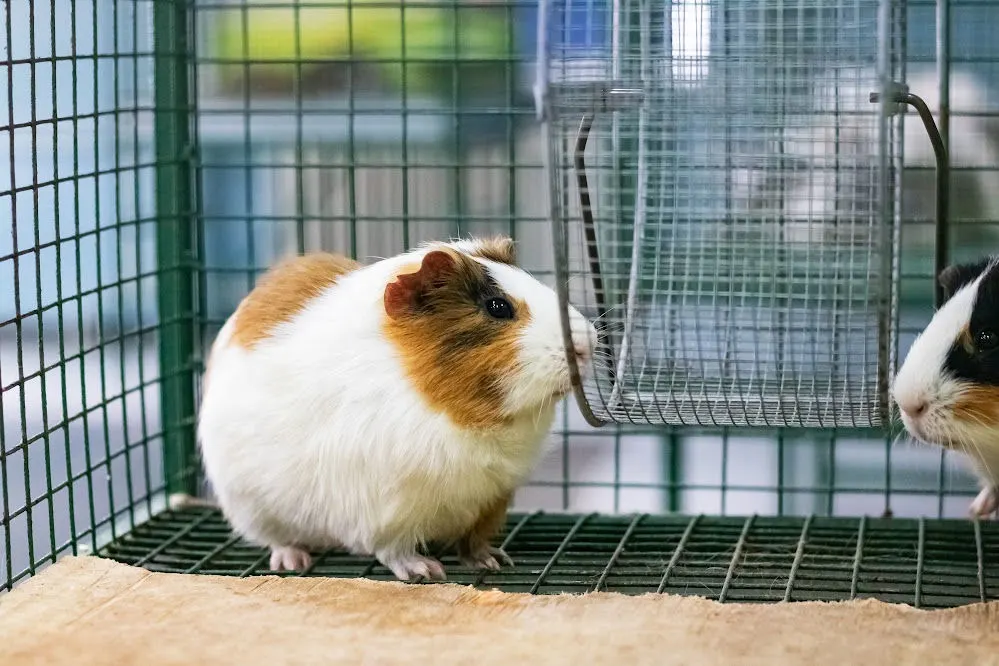As lovely as they are, guinea pigs require more space than most people may realize. As an animal lover, it’s important to ensure that your furry friends have more than enough space to remain happy and healthy. With that said, finding the right-sized cage for your guinea pigs can be tricky, especially for first-time owners.
Overall, guinea pigs are pretty easy pets to keep: they are relatively low-cost compared to most pets, and they don’t need very much to be content. However, since they are social creatures, it’s always recommended that they have another piggy friend to keep them company.

If you have at least a pair of guinea pigs, it might be a good idea to get a bigger cage. Here’s all the info you need to know about the perfect cage size for fully-grown guinea pigs.
Recommended cage size for guinea pigs
While no animal should spend their days in a cage, it’s almost impossible to keep small pets safe without one. Guinea pigs love having plenty of space to explore, so the best solution is to get a cage that’s spacious and enriching.
Whether you’re in the UK or the USA, the minimum cage size for one guinea pig is seven-and-a-half square feet (0.69 square meters). Both the Humane Society of the United States and the RSPCA enforce this minimum requirement. However, veterinarians and guinea pig enthusiasts recommend giving them a little extra space if you can.

Cavies generally benefit from having a cage mate. In this case, a slightly larger cage, around 10.5 square feet (0.98 square meters), is a great size for two guinea pigs.
In addition to having enough square feet of space, your guinea pig’s cage should be at least 12 – 15 inches (30 – 38 cm) tall. When buying enrichments for your guinea pig housing, make sure to consider the cage size requirements.
How much space does each guinea pig take up?
Starting at a minimum of seven-and-a-half square feet (0.69 square meters), your cage should increase by at least three to four square feet (0.37 square meters) per additional guinea pig. Cavies are a lot like humans; while they need to socialize, they also need space to be alone.
Four square feet (0.37 square meters) per additional guinea pig is a decent minimum space requirement. However, a little extra space than that won’t hurt. It’s also important to remember that the more cavies you keep, the more enrichment your cage will need. You should consider that when buying a cage, too.

Guinea pig enclosures should have plenty of free floor space and a few nooks for them to retreat to. Extra room is especially important if you’ve got a herd (yes, that’s what a group of cavies is called) of male guinea pigs, as they tend to be more territorial.
Why do guinea pigs need large cages?
One of the keys to having a healthy and happy guinea pig is having the right cage. Guinea pigs are extremely active and very social animals. In fact, they’re active for around 18 – 20 hours a day and take short snoozes to recharge in between.
Because of their active nature, guinea pigs that do not have enough space to move around can experience health issues or become depressed. Active guinea pigs are healthy guinea pigs.
But, while keeping them active, you should also follow a recommended guinea pig diet with veggies and fruits and monitor your guinea pig’s fecal production for any signs of ill health.
Small cages are not good for your guinea pigs’ health
Without ample space to burn off calories, guinea pigs are at greater risk of developing severe health conditions such as obesity, heart disease and respiratory issues.
Besides that, a small cage quickly becomes dirty, which can cause guinea pigs to develop sores, matted fur, and infections. Dirty cages also put guinea pigs at risk of fly strike, which is dangerous and painful for your pets.

When guinea pigs live in unsuitable enclosures, they quickly become depressed. Without enough enrichment and space to roam, cavies tend to isolate and hide away from interaction. They may also lose their appetite and sleep a lot more from being a bit depressed, much like humans.
Guinea pigs become aggressive when confined
Guinea pigs are among the largest rodents kept as pets, so ensuring you have enough space to house one is very important. If you have more than one, you might have more of a problem on your hands. These cavies need to socialize, but having two in close confines is not a good idea.
While a single guinea pig may become depressed on its own, keeping two or more guinea pigs in a small space will cause them to become aggressive toward their cage mates. This especially occurs among male guinea pigs. Close confines can also increase a guinea pig’s stress, which can in turn decrease their ability to fight illness and infections.
Cavies do not utilize vertical space
Unlike most rodents, guinea pigs don’t make as much use of vertical space. This means that having a tiered cage may not be beneficial. Finding cavies that enjoy climbing is rare. However, most guinea pigs will utilize a low-angle ramp to access a second story of their cage as long as it has good traction. Besides that, wire floors and plastic tubes are not suitable for guinea pigs because it puts them at risk of injury.
First-time guinea pig owners often think that guinea pigs and hamsters are very similar, but you’ll soon find that they are very different from their smaller cousins.
Do guinea pigs prefer indoor or outdoor cages?
Having the right size cage is the first step, but you’ll also need to keep your guinea pigs in the right environment for them to be happy. A significant amount of space is needed for your piggies, and many people think that housing them outdoors is okay. This is where things get tricky.
Guinea pigs are sensitive little beings that don’t do well in very warm or cold climates. They are highly prone to heat stroke, and although they’re covered in fur, cavies can quickly succumb to the cold.
Wild guinea pigs originate from South America’s Andes Mountains and are much more resilient to the climate than their domesticated kin. Domesticated guinea pigs need to be kept in temperatures between 65°F (18°C) and 75°F (23°C) to be healthy and happy.

When the temperature is favorable, it’s okay to let your guinea pigs enjoy the fresh air in a safe outdoor enclosure. Outdoor cages should not be in direct sunlight, and you should ensure plenty of cool shade for the cavies to enjoy.
Outdoor enclosures will also need to be more secure than indoor enclosures, and leaving your guinea pigs unattended outdoors is not recommended if you have an open-top pen.
Your indoor cage shouldn’t be near any heat sources or air vents. Guinea pigs enjoy dry and mild conditions, so try to keep them away from humidity as well. Also, though guinea pig cages should have proper ventilation, be sure to place them away from drafty areas where they could get cold.
What to do if you don’t have enough indoor space?
Getting a guinea pig or two without the necessary space is not recommended. But, if you’ve already got a cavy and are looking for temporary fixes to keep your pet happy while you find the perfect cage, there are a few things you can try.
Get an exercise pen for guinea pigs
These temporary structures are a great solution to ensure your piggies are active. You can get a simple pen from most pet stores or have a look online. Typically they’re foldable and easier to adjust to your home environment than standard cages.
Letting your piggies spend a few hours in an exercise pen with plenty of toys for enrichment and stimulation is a great solution to having limited space. After a few hours, you can put them back into their cage to rest and fold up the pen before storing it away.

Doing this at least twice daily is the best way to keep your guinea pigs happy until you find a large enough cage.
Clean your guinea pig cage often
Guinea pigs can easily develop health problems when their living environment is unclean. Smaller cages tend to get dirty more quickly because of less surface area. Guinea pigs can’t clean up after themselves, so you’ll need to clean their enclosure more often than usual.
Like humans, it’s important that your guinea pigs have a “kitchen area” for their water bottle and food bowl, which is away from their general living area. Keeping their food dishes away from guinea pig poop is important to maintain a clean environment. Fully grown guinea pigs poop a lot, so it can be hard to keep things clean.
Remember that you shouldn’t bathe your guinea pig often because they are generally very good at grooming themselves, but that can be tricky in a dirty cage. Guinea pigs should take a maximum of only three baths per year, so keeping their cage clean is one of the most important factors in having healthy cavies.
Supervised outdoor playtime
As mentioned earlier, outdoor playtime can be beneficial to your guinea pigs as long as it’s safe.
Although guinea pigs are fairly large, they are still at risk of threats when left outside. Guinea pigs can quickly slip under the radar and get lost in the wilderness of your backyard or find themselves in a standoff with large birds and snakes.
To avoid this, you can buy a secure pen with small gaps (under 1 inch) between the bars and a mesh or wire lid. These pens are more suitable outdoors because they’ll keep your cavies in and keep any uninvited guests out.

If you have an open-top outdoor playpen, you must supervise your piggies during playtime. This can be inconvenient, but it’s important if you want to keep your cavies safe. Also, ensure plenty of shade, water, and some tasty treats.
Best guinea pig cage and pen to buy
So now that you know all the facts and how big your guinea pig enclosure should be, you’re probably wondering which cage to buy. There are many good options available that are perfect for guinea pigs, many of which fall under the C&C brand. Here are a few of the other best cages for cavies.
Midwest Guinea Pig Habitat
Much like a C&C cage, the Midwest Guinea Pig Habitat is a spacious and comfortable enclosure for guinea pigs.
Midwest’s habitat cage offers eight square feet (0.74 square meters) of space and is 14 inches (35 cm) high. The great news is that you can purchase a variety of extensions and cage accessories to make your piggies even happier.

Instead of a coroplast base, this cage comes with a canvas bottom that’s durable and leakproof, thanks to its PVC lining. The canvas bottom is great for insulation and might make cage maintenance a little easier, too.
Langxun Small Animal Play Pen
This one is perfect for fully-grown cavies. Although the playpen comes in a few sizes, the best sizes for guinea pigs would be the 16 or 24-panel models. This will provide your cavy with at least 14 square feet (1.3 square meters) of space to enjoy.
This playpen is best for guinea pig owners with plenty of floor space. It doesn’t come with a base, so you’ll have to buy or make a base for easy cage cleanup.

What makes this pen worthwhile is its easy assembly and durability. The panels simply join together by slotting into a connector. The Langxun playpen is also suitable for outdoor use. However, it does not come with a top cover, so you’ll need to supervise your piggies during their outdoor playtime.
Guinea pig cage size: final thoughts
Before buying a guinea pig, there are some factors to consider. But making sure you have enough space is one of the most important things. While guinea pigs are fairly hassle-free pets, it’s essential to house them in a happy and healthy environment.
Now that you know everything you need to know about how big a guinea pig’s cage should be, you’re ready to pick up your new furry friend.
If you found this cavy guide helpful, you might also enjoy this read on setting up a guinea pig cage with fleece.
Steph Dyson is a travel journalist by trade but a lover of all small pets. She’s been a pet mum to everything from gerbils to guinea pigs, rabbits to hamsters, and fish to dogs of all shapes and sizes. She wants to share her years of experience with small pets and make Small Pet Guides the go-to website for pet owners seeking information and care advice.

